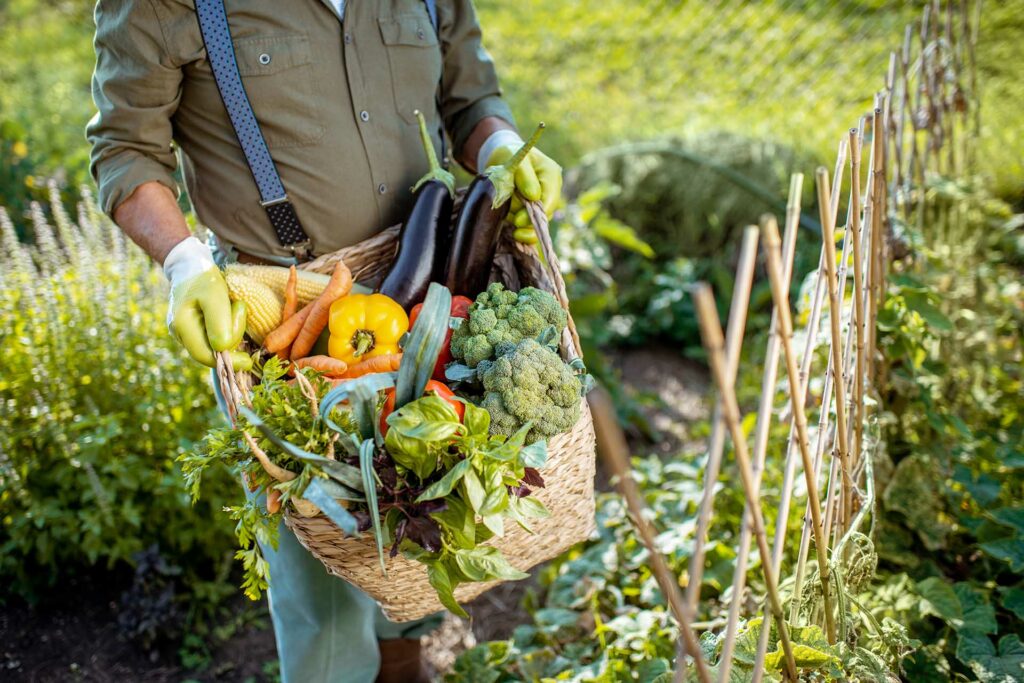Imagine tracing the journey of a grain of wheat from its birth in the golden fields, through its transformation into a loaf of bread, and finally to your breakfast table. That image you’re seeing in your head? That’s “Farm to Table”. It’s a movement that’s shifting the way we, and large industry players, think about food. More than just a culinary trend, it represents a shift towards sustainability, transparency, and a celebration of local produce.
In this article, we’ll investigate its roots and its impacts. Plus we’ll share how it’s reshaping our relationship with food. So, whether you’re a seasoned foodie or a novice exploring the food world, prepare for an enlightening journey into this captivating movement.
Unraveling the Farm to Table Phenomenon
A journey into Farm to Table is much like tracing the route of a ripe, sun-kissed tomato plucked from a local farm, making its way to your dinner plate, bursting with flavor and nutrients.
Decoding the Concept
Imagine biting into a fresh, juicy apple. Now, think about this apple’s journey: picked from a nearby orchard, it’s traveled only a short distance, avoiding long trips in refrigerated trucks. Its vibrant flavor is a testament to its freshness, having never seen the inside of a storage facility. This is the essence of Farm to Table. It’s a food system that values proximity, freshness, and transparency.
Farm to Table is all about shortening the distance between the farm and your plate. It’s about celebrating seasonal produce, supporting local farmers, and reducing our carbon footprint. It’s also about transparency. The aim is for consumers to know who it was that grew their food, and the journey that it’s gone on.
A Journey Through Time
Much like an heirloom seed passed down through generations, the roots of the Farm to Table movement stretch deep into our past. Picture a time when food didn’t come neatly packaged in supermarkets but was grown in backyard gardens or sourced from a neighboring farm. This was the reality before the rise of industrial agriculture when food was local, seasonal, and inherently sustainable.
However, as industries grew and globalization took hold, our food system transformed. It became a complex web of long-distance transportation and large-scale production, often sacrificing flavor and quality for convenience and profit.
Against this backdrop, the Farm to Table movement sprouted like a resilient seedling. It was a call to return to our roots, a response to growing concerns about health, sustainability, and the loss of connection with our food sources. In the last 20 years or so, pioneering chefs and restaurateurs began to champion the cause. Those industry heroes drew the interest of the general public. Fast forward to today, Farm to Table is more relevant than ever. It feels like there’s a genuine collective desire for a sustainable, nutritious, and locally-rooted food system.
The Compelling Importance of Farm to Table
Why does Farm to Table matter so much? Its significance stretches beyond just fresh and tasty meals; it profoundly impacts our health, environment, and local economies.
A Feast of Nutritional Benefits
Have you ever noticed how much more vibrant and intense freshly picked fruits and vegetables taste compared to their supermarket brethren? That’s because the shorter the time from farm to fork, the less nutritional value our food loses. When produce is picked and consumed at peak ripeness, it not only explodes with flavor but also delivers maximum nutrients. Farm to Table delivers the highest levels of nutrition for our bodies from the freshest produce without the need for artificial preservatives.
Farm to Table: A Friend to the Environment
The beauty of a local, ripe strawberry isn’t just in its taste; it’s also in the environmental savings. Traditional food supply chains often involve long-distance transportation, contributing significantly to greenhouse gas emissions. By shortening the journey from farm to plate, we reduce our carbon footprint. It’s not just about supply chains, Farm to Table promotes sustainable farming practices on the farms themselves too. This helps to maintain soil health, preserve water resources, and protect biodiversity. It’s a delicious way to do our part for Mother Earth!
Boosting Local Economies: One Bite at a Time
Every time we choose local produce over imported goods, we’re investing in our community. We’re supporting local farmers, artisans, and restaurateurs, keeping our hard-earned money within the community. The Farm to Table movement creates job opportunities, strengthens local food systems, and fosters a sense of community pride. Your locally sourced breakfast isn’t just nourishing you; it’s nurturing your local economy too!
A Glimpse into the Journey from Farm to Table
Engaging with the Farm to Table movement means appreciating the complex ballet of hands that work in harmony to bring fresh, nourishing produce to our plates.
Farmers: The Guardians of the Soil
Farmers are the real-life heroes of the Farm to Table movement, tending to the soil and the seed with diligence and care. Farmers know, better than anyone, about the land, the crops they grow, and the seasons they work within. This combined knowledge allows them to grow food of the highest quality. The most forward-thinking of them will employ sustainable farming practices. Sustainable farming is often organic or biodynamic and focuses on maintaining the health of the soil and the ecosystem. It’s about more than just enjoying the food when you eat locally. You’re taking stock of the love and labor of a local farmer dedicated to the land in your local area.
Chefs and Restaurateurs: Culinary Artists with a Cause
From the farms, our journey takes us to the realm of the culinary wizards. The chefs and restaurateurs who breathe life into fresh produce, transforming it into unforgettable meals. Committed to quality and sustainability, these professionals carefully select local, seasonal ingredients, creating menus that reflect the bounty of the region. They build direct relationships with farmers, sometimes even visiting the farms themselves, to ensure they source the best of what the season has to offer. Their innovative dishes not only tantalize our taste buds but also tell a story of the land and its produce.
Consumers: The Driving Force
The final, but equally important player in the Farm to Table journey, is you, the consumer. The choices you make not only affect the local economy but also the health of the planet. By choosing to support restaurants and markets that source locally, asking about the origins of your food, or even growing some of your own, you become an active participant in this movement. You vote with your fork for a food system that values quality, transparency, and sustainability. Your role in the Farm to Table journey is not just as a passive recipient, but an active catalyst for change.
Experiencing Farm to Table in Regina
How does the Farm to Table movement play out in a city like Regina? There are growing examples around the world of sustainable, Farm to Table hubs. Regina is just one of them,

Regina’s Flourishing Farm to Table Ecosystem
Picture the fertile soils of Saskatchewan, the golden waves of wheat, the lush market gardens. Regina, nestled in this bountiful landscape, is a vibrant hub for the Farm to Table movement. The city is surrounded by local farms and producers dedicated to sustainable practices, growing everything from heritage grains to heirloom vegetables, and grass-fed meats. Farmers markets in Regina are lively, community-oriented events, where consumers can meet the farmers, learn about their practices, and take home a basket full of locally grown treasures.
Restaurants in Regina
In the heart of Regina, culinary magic is happening. Restaurants are crafting innovative, delicious dishes using ingredients sourced from the surrounding farmlands. The menus change with the seasons, reflecting the diversity and richness of Saskatchewan’s produce. The restaurants in Regina are not just places to eat; they are destinations where diners can experience the essence of the region on a plate. When consumers pick Farm to Table restaurants they support the network of local farmers, chefs, and artisans dedicated to bringing the best of the farm directly to your table.
Navigating the Challenges and Opportunities in the Farm to Table Movement
All of this, brilliant as it sounds, is not without challenges. However, these hurdles also present opportunities for innovation and growth.
Navigating the Terrain of Challenges
The path to bringing food from the farm to the table isn’t always smooth. For smaller farmers, challenges include the unpredictability of weather and the high costs of organic farming. For restaurants and markets, sourcing exclusively local and seasonal ingredients requires flexibility and creativity in menu planning. For consumers, accessing locally grown produce can sometimes be less convenient than a quick trip to the supermarket.
Moreover, the term “Farm to Table” itself is not regulated, which means it can be used misleadingly to market food that doesn’t truly adhere to the principles of the movement.
Seeding Innovation and Solutions
Despite these challenges, the Farm to Table movement continues to grow, fueled by the innovative solutions being implemented by its stakeholders. Farmers are adopting new technologies and sustainable practices to increase yield and resilience. Chefs are crafting inventive menus that highlight underused local ingredients, reducing food waste in the process. Consumers are forming community-supported agriculture (CSA) groups and are organizing local food co-ops. Both with the aim of increasing access to fresh, local produce.
Moreover, many regions are developing certification programs to validate genuine Farm to Table practices, helping consumers make informed choices. As we continue to navigate the challenges, it’s these innovations that strengthen the Farm to Table movement, making it more robust and resilient.
Key Takeaways
Farm to Table isn’t just a passing fad. Nor is it a short-lived trend. It’s a movement and one that’s here to stay. The ever-growing group of dedicated individuals from farmers to chefs to consumers is aligned with the cause and is sure to see it go from strength to strength.
- Everyone has a part to play in Farm to Table.
- There’s a genuine impact on the local economy and the health of the planet at stake.





